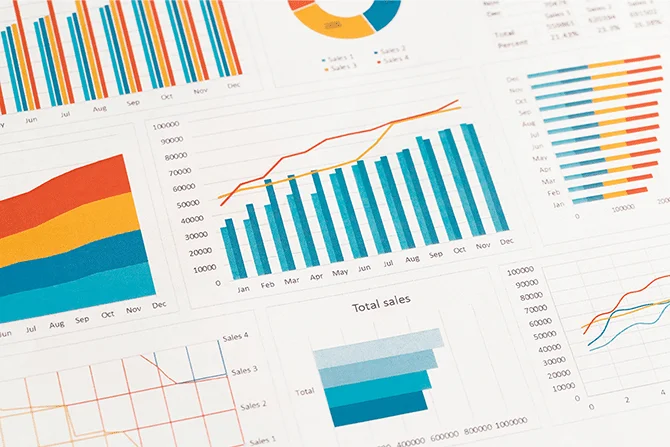by Charles Parat, Data Consulting Director
PERFORMANCE MANAGEMENT :
determining the key indicators that show risk and performance levels
and predicting their development in order to achieve
both operational and strategic objectives
Whether you are managing a project, strategy or company, key indicators need to be put in place to allow you to determine if the objectives set have been achieved.
These key indicators are the famous KPI (Key Performance Indicators) and also the lesser known KRI (Key Risk Indicators) which warn you of any potential below average performance.
The key indicator rationale leads to several problems:
- How do we create indicators that are genuinely key and relevant, not merely measurements that we “know how to calculate” but ones that help us understand performance?
- How do we ensure that we actually have the means to produce these indicators on the basis of available data?
And can we produce them regularly on a relevant time scale?
- How can we reliably predict how these indicators will evolve over time?
Who has the necessary skill and authority?
- What presentation should we choose to ensure that all persons involved have an immediate understanding of the important information relating to them?
Some companies build their own management applications, others turn to specialist publishers.
Numerous consultancies have already studied performance management. These include the renowned Gartner consultancy which contributed to classifying EPM (Enterprise Performance Management) applications under four main headings:
- Planning and budgeting applications
- Cost management applications
- Financial consolidation applications
- Strategic alignment management applications
We will now look at the real value of this classification.
Planning and budgeting applications (development and monitoring)
These applications concern all areas of a company’s work, as soon as forecasts are taken into account: HR, purchases, production, stock, logistics, sales, distribution, maintenance, fixed assets, cash flow, and so on. They also have the capacity to coexist on joint reference documents, for example in Sales and Operations Planning, where operations are adjusted according to sales forecasts and the chances of implementing the order book.
The budget application is often an overlay in the forecasts of different work areas. The development process often predicts constrained sequences of a work area’s forecasts to enable another work area to do its accounting.
Putting forecasts into perspective over set time-frames and different levels of granularity allows budgets to be combined with long or medium term plans.
Cost management applications
(This does not refer to Industrial Cost Price applications which are normally to be found within ERPs in dedicated controlling functions)
When trying to establish the cost-effectiveness of a company, a department, a sales channel, a product or anything else, we aim to determine as accurately as possible the “total cost” of the product or service so that we can guarantee its cost-effectiveness when setting the price according to volumes.
Creating cost allocation rules for establishing a total price is a process that is both complex and flawed. We often talk about cost based on the cost of the activities (and the resources they require) which allowed the product or service to be delivered (ABC: Activity Based Costing).
Cost management applications are thus indispensable for determining prices or, for instance, delivering specifications when producers negotiate prices and volumes with their distributor.
This is also what enables IT management to decide on prices for their internal services catalog in preparation for billing other company departments for IT services.
Consolidation applications (mainly financial)
We should specify here that we make a formal distinction between financial or statutory consolidation and management consolidation.
But in both cases, this is about collecting and consolidating all the data that enables us to calculate indicators through hierarchies of the various analysis axes, with a view to circulating a statement of performance measured on all these levels.
Management consolidation obeys the company's internal rules and its specific management constraints. This is a standard structuring element of management communication based on operational performance indicators of the various activities: sales, production, numbers, customer satisfaction, quality, and so on.
Financial consolidation obeys the specific strict external national or international accounting rules (GAAP and/or IFRS) to which the company is subject. The production and dissemination of physical or digital reports is also a codified exercise.
At the same time as dealing with these accounting consolidations, companies have to contend with an increasing number of local and international standards related to activity and results publication, in particular in the field of Corporate Social Responsibility (CSR).
Entire sectors are subject to specific publication rules involving consolidation and reporting mechanisms for specific authorities (Banking and Insurance, Chemical, Agri-food, Industrial, Transport, etc.).
Strategic alignment management applications
These applications can display a company’s strategy and the aims it is pursuing, the extent to which the strategic objectives are being met and potentially allow the adverse effects of contradictory indicators to be measured: for example, a maintenance company may have an HR objective of retaining qualified personnel by increasing salaries, and a financial objective of improving margins on its service provision while at the same time offering rates that are close to those of its competitors. Ingenious action plans need to be found to solve this type of equation: retaining objectives while at the same time avoiding the negative impacts of one on the other.
With a good level of communication adapted to the various stakeholders, these applications allow each individual to take responsibility for his or her role and make an enlightened contribution to the successful implementation of the strategy.
From the bottom of an organization to the top, each individual's objectives can be aligned with those of his or her line manager.
Defining indicators to illustrate objectives at all levels is a complicated but necessary exercise in ensuring consistency.
The major value of these applications lies in determining shared action plans to ensure that the results predicted are achieved. These results will inevitably have an impact on the budget applications referred to above.
- - -
For analysts who install these types of EPM applications, the advantage lies in spreading the word about this essential company tool. This also allows a comparison to be made of the many software publishers on the market, both technical software and software packages.
The reality is that we know that this array of applications is not in widespread use in organizations, despite the fact that the need is there. Very often the processes are still manual and carried out on tools intended for office use, spreadsheets in particular.
The developing and monitoring of budgets and re-forecasting is mainly carried out, at least in part, on spreadsheets with files of varying formats being exchanged via unsafe channels.
Consequently, although a company may have structured itself to present the necessary data for operational management in a safe and controlled way, what we often find at a more strategic level is a series of processes carried out by stressed humans using office devices that are neither centralized nor controlled. Fortunately, all involved do their very best, but the time-frames are always too limited for producing information that may be critical and sensitive.
The risk of errors in the results and pressure in teams is ever-present with spreadsheets, the hurried extraction of data and unwelcome and untraceable “corrections”.

The work is obviously even longer and more risky when those involved in these processes have to secure the data extracted from source systems themselves.
Whatever the solution chosen (specific or software package), the crux of the matter lies in reconciling the main features of an EPM application:
- Structuring the shared centralized repository of indicators and their contributory data
- The capacity for acquiring and absorbing data sources
- The collaborative management of stakeholders’ contributions (interfaces and workflow)
- The production and dissemination of the information anticipated (extractions, reports, analyses, etc.)
As far as is necessary, a management culture spreads through the company and it is easy to achieve a stack of management applications enabling each organizational layer to take responsibility and ensuring consistency in operational and strategic levels:

Suggested reading :
Business Intelligence in 3 steps
Process Intelligence : understand how data flows




